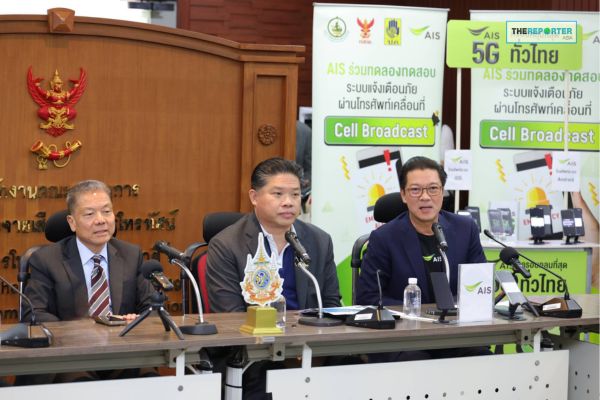Thailand has taken a significant stride towards bolstering its national public safety infrastructure following a successful test of the Cell Broadcast emergency alert system, confirmed today by Advanced Info Service Public Company Limited (AIS) and the National Broadcasting and Telecommunications Commission (NBTC). The test verified the system’s compatibility across both Android and, crucially, iOS platforms, following Apple’s recent integration of Cell Broadcast support for Thailand in its latest iOS 18 update. This development paves the way for more immediate and widespread dissemination of critical warnings, with AIS strongly urging iPhone users to update to iOS 18 to enable this vital feature.
In a critical move designed to enhance the nation’s resilience against emergencies and natural disasters, Thailand’s leading digital infrastructure provider, AIS, in close partnership with the regulatory body, NBTC, conducted a landmark test of the Cell Broadcast mobile emergency alert system on Friday, April 18, 2025. Held at the NBTC auditorium, the successful trial signifies a major advancement in the country’s ability to communicate urgent information directly to the public’s mobile devices, regardless of network congestion, which often plagues traditional SMS systems during crises.
The test’s success hinges significantly on the recent expansion of Cell Broadcast compatibility to include iPhones. Apple’s rollout of support for this technology within iOS 18 specifically for users in Thailand was a key enabler, bridging a previous gap and ensuring a broader reach for future emergency notifications. Prior to this, the Cell Broadcast system primarily functioned on Android devices (version 12 and higher). The successful demonstration across both dominant mobile operating systems marks a unified approach to public safety communication technology.
Attending the successful test were key figures spearheading this initiative, including Mr. Trairat Viriyasirikul, Acting Secretary-General of NBTC, Mr. Waroonthep Watcharaporn, Head of Business Relations at AIS, and Mr. Wasit Wattanasap, Head of Nationwide Operations and Support Business Unit at AIS. Their presence underscores the collaborative effort between the national regulator and major telecom operators in deploying this critical infrastructure. This collaboration is pivotal, as the technology relies on mobile network infrastructure to push alerts to defined geographical areas.
Cell Broadcast technology differs fundamentally from standard SMS. It operates on a one-to-many basis, allowing authorities to send a single message that is broadcast simultaneously to all compatible devices within a designated zone, rather than sending individual messages to specific numbers. This method is highly efficient, significantly faster, and crucially, does not suffer from the network overloads that can delay or prevent SMS delivery during large-scale emergencies when communication is most critical. The economic implications are substantial; faster warnings can lead to timely evacuations, reduced property damage, and potentially save lives, minimizing the overall economic disruption caused by disasters.
While this successful test represents a major step forward, the full implementation of a centralized national alert system is still underway. The Department of Disaster Prevention and Mitigation (DDPM) is currently developing the Cell Broadcast Entity (CBE), which will serve as the central government command and control system for issuing these alerts nationwide. In the interim, the DDPM has requested the cooperation of mobile operators like AIS to utilize a dual-system approach for disseminating emergency information.
This interim strategy involves using both the newly tested Cell Broadcast Service (CBS) via the operators’ networks and the traditional SMS system. The CBS component leverages the capabilities now available on Android devices running version 12 or higher and iPhones updated to iOS 18. However, recognizing that not all citizens possess compatible devices, the DDPM has mandated the continued use of SMS alerts.

There are specific limitations to the current Cell Broadcast Service implementation that necessitate the parallel SMS system. CBS technology is not supported on older 2G and 3G mobile devices, which, although declining in number, are still in use by a segment of the population. Furthermore, iPhones predating the models capable of running iOS 18 (specifically, iPhone X models and earlier) cannot receive these Cell Broadcast alerts. Therefore, the SMS system remains essential to ensure warnings reach users with these older devices or incompatible operating systems.
Under this dual approach, the DDPM will retain control over the content, timing, and geographic targeting of alerts distributed via SMS. These messages will be clearly identifiable, sent using official sender names such as “DDPM” or “TMD” (Thai Meteorological Department), helping recipients recognize their legitimacy. Mobile operators like AIS facilitate the transmission based on DDPM directives for both CBS and SMS during this transitional phase.
The push for a robust Cell Broadcast system aligns with international best practices for emergency preparedness. Many countries globally rely on this technology for its speed and reliability in delivering geo-targeted alerts for events ranging from severe weather and earthquakes to public health emergencies and security threats. For Thailand, a nation prone to various natural events like flooding and storms, the full implementation of a comprehensive Cell Broadcast system managed via the central CBE will significantly enhance public safety and national resilience.
AIS, as a major player with over 45.8 million mobile subscribers and extensive 5G network coverage, plays a crucial role in this national initiative. The company’s commitment, alongside the NBTC’s regulatory guidance and the DDPM’s overarching strategy, forms the backbone of this technological upgrade to the country’s emergency response framework. The successful test is not just a technical achievement but a demonstration of the coordinated effort required to protect citizens.
The immediate call to action resulting from this test is directed squarely at iPhone users in Thailand. Updating to iOS 18 is no longer just about accessing new features; it is now a critical step in ensuring personal and public safety by enabling the reception of potentially life-saving Cell Broadcast emergency alerts. Public awareness campaigns are expected to follow to educate users on the importance of this update and the nature of the new alert system. As Thailand moves towards the full operationalization of the central CBE, the cooperation of the public in ensuring their devices are ready is paramount. This technological advancement represents a significant investment in the safety and security infrastructure of the nation, promising faster, more reliable communication when it matters most.
#Thailand #EmergencyAlert #CellBroadcast #NBTC #AIS #PublicSafety #iOS18 #Android #DisasterPreparedness #TechNews #Telecom #DigitalThailand #DDPM






